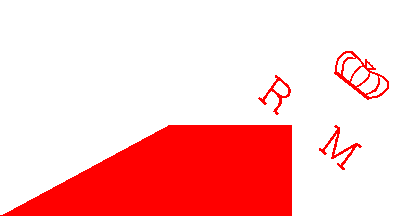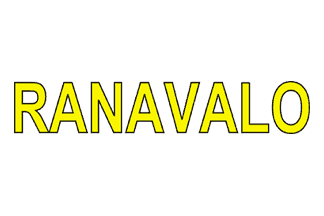
Last modified: 2022-10-22 by bruce berry
Keywords: merina | ranavalona iii |
Links: FOTW homepage |
search |
disclaimer and copyright |
write us |
mirrors
Merina rulers:
Radama I - 1819-1828
Ranavalona I (Queen) 1828-1861
Radama II - 1861-1863
Rasoaherina (Queen) 1863-1868
Ranavalona II (Queen) 1868-1883
Ranavalona III (Queen) 1883-1896
Jarig Bakker, 05 Mar 2002
![[Merina flag]](../images/m/mg_merin.gif) image
by Jarig Bakker, 18 Jul 2005
image
by Jarig Bakker, 18 Jul 2005
Imerina or Merina is on the Central Highlands of Madagascar, around
the capital Antananarivo.
On this
website two flags are reported:
1810-1885 White over red bicolor. Image based on a small image by Jaume
Ollé, based on Flag Bulletin, X:2/3, 1971 and Lucien Philippe's,
Les anciens drapeaux de Madagascar, 6° ICV, IJsselmeer, 1975.
1885-6 Aug 1896 horizontal blue - white - red; on white towards the
fly a red crescent pointing towards the fly - see here.
Data about the kingdom from the mentioned page:
Ambohimanga (Imernia)
c.1675 Ambohimanga kingdom under the Imernia (or Mernia) dynasty.
1797 Most of Madagascar united under Imernia dynasty.
23 Oct 1817 King Radama I of Imerina, having conquered practically
the whole island, enters into a treaty of friendship and peace with Britain
in which he is recognized as king of Madagascar.
Kingdom of Madagascar.
06 Aug 1896 Kingdom of Imerina under French protectorate.
28 Feb 1897 French Madagascar colony
Kings (personal names in parentheses)
c.1675 - c.1710 Andriamasinavalona
c.1710 - c.1730 Andriantsimitoviaminiandriandrazaka (d.
c.1730)
c.1730 - c.1770 Andriambelomasina
(d. c.1770)
c.1770 - 1787 Andrianjafy (Andrianjafinandriamanitra)
1787 - 1810 Andrianampoinmerina (Ramboasalama)
(b. c.1745 - d. 1810)
1810 - 27 Jul 1828 Radama I "the Great" (Lehidama) (b. 1792 - d. 1828)
27 Jul 1828 - 28 Feb 1897 the rulers of Madagascar
The UNESCO General History of Africa, vol. V, 1992, has this to say:
Imerina became a centralized kingdom in the beginning of the 17th century
under Ralambo; its population consisted of the Vazimba and Hova peoples.
He was succeeded by his son Andrianjaka, who founded Antananarivo. His
son and grandson distinguished themselves mainly by adding letters to their
royal names (lord-above-lords and lord-above-greatest-of-lords, with 33
letters in Malagasy). His great grandson Andriamasinavalona pursued a policy
of aggressive expansion - but committed the blunder of dividing his kingdom
in four parts for his four sons; two in the north, centered around Ambohitrabiby
and the necropolis of Ambohimanga (where "no boar, dog or stranger could
set foot, as tradition has it). One kingdom was in the south around Antananrivo,
and one in the west with its capital at Ambohidratrimo.
Imerina became a scene for internal wars, until in the 1770's Ambohimanga
took control. From then on Imerina started to conquer the whole island
of Madagascar.
Jarig Bakker, 18 Jul 2005
 image
by Paige Herring 1 January 1999
image
by Paige Herring 1 January 1999
This flag is recreated from a picture of a German Cigarette card which
reproduced the flag of Queen Ranavalona III. The flag was shown in reverse;
therefore, I have reproduced it as such. I'm not sure if the lettering
on the obverse would have been in mirror form or in a readable form.
Paige Herring, 1 January 1999
The last indigenous monarch, Queen Ranavalona III, used a flag of diagonally
red over white with her royal cipher (crown over R M) over all (Crampton,
The
World of Flags, 1990, p65) [cra90].
Roy Stilling, 11 October 1996
According "Les drapeaux de Madagascar" by Lucien Philippe, book made
from a communication in an International Congress, Queen Ranavalona
I used a white flag with her name (in red) and below the name the word
"manjaka" (Queen).
In the book by D. Ruhl "Die Flagge des kriegs und handelsmarinen"
(1885, 1887) is quoted the ensign shown. But, in opinion of Karl Fachinger,
this was an error, and the real flag was Blue-White-Red with the monarch's name
in gold. Later Queen Ranavalona III had a personal standard comprising the
French flag with golden
royal crown in the white band, and below the crown, the letters R M.
Jaume Ollé, 7 January 1999
The source from which I got the image is Crampton's
Flags of the World, 1990. The image is under the Malagasy (I've done
my research into adjectives) section. I've read other descriptions, the
Ranavalona III image is the first picture. My assumption, based on what
little I know of the cigarette card heyday, would be that the image would
be from prior to World War II. My last thought is that I doubt that the
flag could be hers since was she deposed in 1897.
Paige Herring, 06 Jan 1999
 image
by Ivan Sarajcic, 06 Jan 1999
image
by Ivan Sarajcic, 06 Jan 1999
I've detected the flag that is evidently related to Calvin Paige Herring's
Queen Ranavalona's flag. Yellow letters "RANAVALO" (black outline) are
on the white background. This is the only unfamiliar flag to me from the
little guidebook called "Taschenbuch für die Kriegsmarine mit Kalendarium"
(Adolf Sponholz Verlag - Hannover 1944). It is listed in section "Die wichtigsten
Flaggen der Welt (Forsetzung)" among the other flags of independent countries.
As far as I know, Madagascar was French colony at that time (1944), wasn't
it? Maybe "Ranavalo" flag was Queen Ranavalona's personal flag?
Ivan Sarajcic, 6 January 1999
Ivan found it in a small handbook for the German Navy, dated 1944. Actually,
there is an earlier evidence in an Italian encyclopedia published in 1938.
On table 377 of "Encyclopedia Pratica Bompiani", vol.1, there is
exactly the same flag attributed to Madagascar, a French colony at the
time. I always considered it to be a mistake, even if all the other pictures
in the table are a common sight in the flag plates of the time. As a matter
of fact, yellow characters on a white background are indeed scarcely visible
and it would be a very poor choice for any real flag. So, it is a surprise
they appear again six years after in a German publication: a case of carbon
copy? And what was it for? Now, I have in mind a possible explanation.
Does anybody know if the word "ranavalo" has a meaning in a local
language? I remember of some cases, in a few modern Italian flag plates,
where a state had a white flag with the words "non disponibile" on it.
Indeed a strange pattern, even with black capital characters - a great
improvement over a yellow motto, though. One point, yet: for those
not too knowledgeable in Italian, "non disponibile" means "unavailable"...
Pier Paolo Lugli, 13 Oct 2003